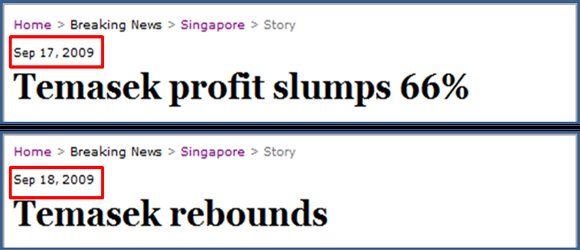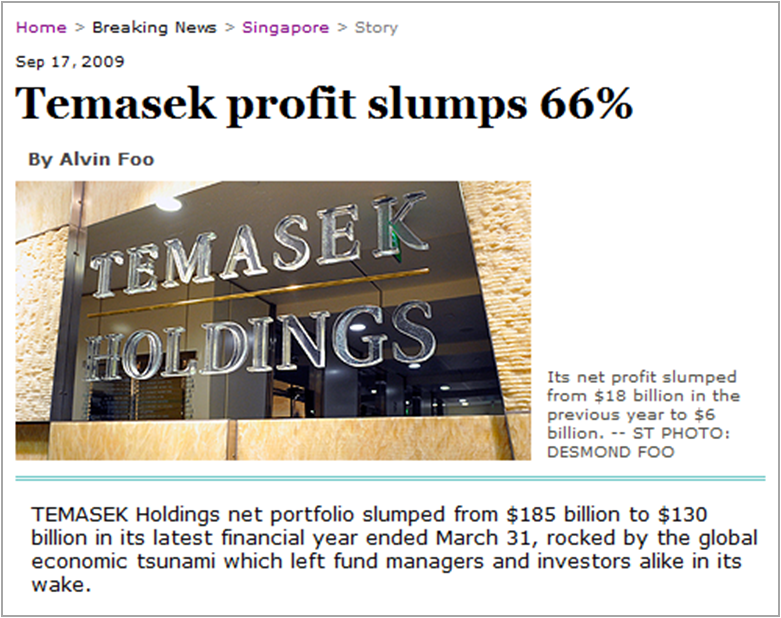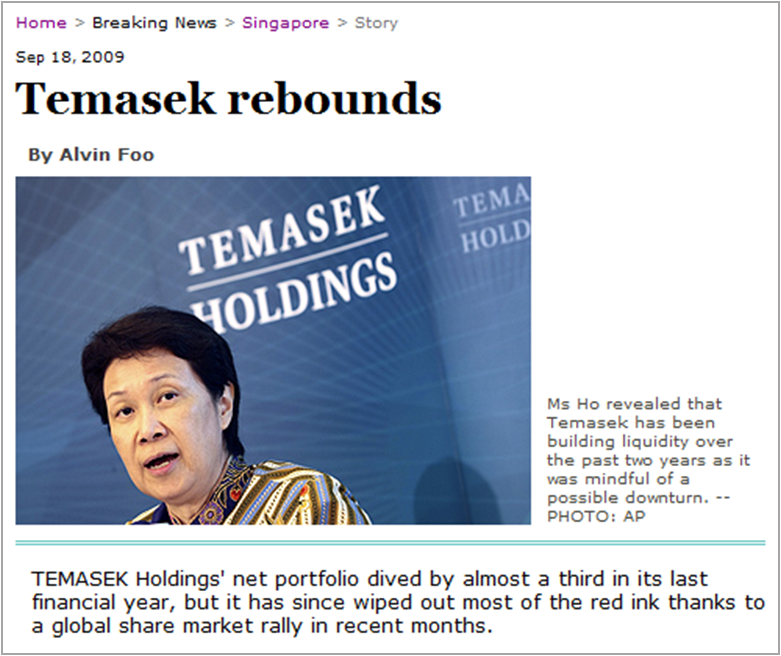Analysing Temasek Holdings’ Review:
-

Sept 17 2009 : Temasek Profit Slumps 66%
Sept 18, 2009 : Temasek Rebounds
Gangasudhan
Temasek Holdings released its annual report on 17th September 2009 which was duly highlighted in the best possible light with a bold header of ‘Temasek Rebounds’ (Straits Times, September 18). Unfortunately, Temasek Review 2009 seems to have more questions than answers (not necessarily a surprise), some which would serve the interests of the fundamental shareholders to be answered – and we are not talking about the Ministry of Finance which is its sole shareholder.
The focus in the report has again predominately been the Portfolio Value which refers to the market value of the various assets under its charge. These include local heavyweights such as Singtel, Standard Chartered, DBS Group and CapitaLand, as well as other overseas entities based in China, India, US and even Brazil. This Portfolio Value has risen steadily over the years from $90 billion in 2004 to $185 billion in 2008 (and in between consecutive years too) before spectacularly dropping by $55 billion in 2009 to $130 billion.
The information from the press and Temasek Holdings contrasts this single drop in portfolio value against previous years’ stellar values and puts the blame of poor performance squarely on the global financial crisis which has taken the world by (thunder)storm.
Value vs Wealth
However, the Temasek Review 2009 (pages 21 and 22) also reveals another figure which is termed ‘Wealth Added’ and reports this value as a ‘negative $68 billion’ (a positive way of saying the ‘Wealth Deducted’ was $68.1 billion) which certainly does not tally with the reported drop of $55 billion in Portfolio Value. The description of the Wealth Added component according to the Temasek Review 2009 includes various components such as operating cost and capital charges, among others.
However, this component conveniently includes any capital injections (whose exact amount would be hidden here) and thus the Portfolio Value of $130 billion which is overemphasised by the parties concerned could very well be lower had the capital injection (if any) not been included in estimating this value.
Illustration
- $68.1 billion includes the market value change (-$55 billion)
- The remaining $13.1 billion ($68 – $55 billion) includes operating costs, capital charges, any opportunity cost involved, and capital injections
- Thus the capital injection could have theoretical been as much as $13.1 billion (if there had been no other charges or expenses) with a probable estimate being $10 billion (based on Temasek Review 2008 – page 19)
Although this may be creative accounting at its best, the implications of not knowing these figures are rather significant. Without knowing whether there was a capital injection and if so, how much, we are left to speculate on the actual loss of the Portfolio Value. Using the figures available in Temasek Review 2009, we can estimate that the ‘true’ Portfolio Value could have been as low as $116.9 billion ($185 – $68.1 billion) as contrasted against the reported $130 billion.
Interestingly, the Wealth Added for 2008 was also a negative value ($6.3 billion) which seems to suggest that any growth in Portfolio Value (for any year’s performance) may not necessarily translate into ‘wealth’. Thus, there is a need to relook the wisdom of using Portfolio Value as a measure of success or performance instead of Wealth Added.
Illustration
Imagine buying your home for $200,000 and boasting about the current market value of $300,000 (implying a profit of $100,000 should you sell). However, if you were to actually sell your home and the various levies, loan interest charges, fees and CPF account reimbursements are then deducted, the net returns may very well be just a few thousand dollars. In this example, the Portfolio Value would be the buying and selling prices of the home and the Wealth Added would be the actual money that you get in your pocket. As can be seen through this example, the price of your home (i.e. Portfolio Value) is hardly anything more than a bragging right and the net returns that you (can) get (i.e. Wealth Added) is what really matters.
Rephrasing 101
This year’s annual report also included the new term ‘retraced its value’ (Temasek Review 2009, page 8 & 18). A rose by any other name may still be a rose but it is apparent that the Temasek Review still holds positive spin above all else. Not content with just one creative adjective, it goes on to add ‘retracted its value’ (Temasek Review 2009, page 6) to further reinforce the implied notion that the drop in value is not a drop in value.
A retracing or retraction of value seems to imply that it was a mere reversal or a rewind to 3 years earlier (2006), but notably, operating costs are NOT at these levels – in fact they are 3 times more in 2009 (Temasek Review 2009, page 28). Also, if the drop in Portfolio Value symbolises a return to 2006, then logic would dictate that salaries paid in 2006 and 2007 should be recovered in tandem. Thus, a play on semantics is not always a good idea, especially on the back of such a catastrophic financial performance.
Illustration
What if you had to take a pay cut that amounts to 3 years’ increment? Could you go around to your creditors and tell them, “Sorry my salary retraced by 3 years.” Would that change anything in the eyes of these creditors?
Signs of desperation
Finally, the Straits Times’ Alvin Foo was more than happy to pen down,
“The portfolio sank from a peak of $185 billion on March 31 last year to $130 billion on March 31 this year, according to its annual report, which was out on Thursday. It also showed that the portfolio had rebounded to $172 billion as at July 31.” Temasek Rebounds (18 September 2009)
However, the reporter failed to realise that the annual report (Temasek Review 2009) made no reference to the ‘magic’ $172 billion and, in fact, this figure appears only in the CEO’s Opening Remarks (page 2). It is therefore very erroneous to suggest that the annual report reports such a figure as the auditors (whose sign off dates 16th July 2009) could not and have not verified this figure to be true, accurate or reliable. It is also quite amusing that Temasek Holdings which prides itself in ensuring that it is always quoted properly has allowed the misrepresentation to exist without corrections – and it is hard not to speculate that the reason is due to the positive inclination of said misrepresentation.
Nevertheless, the discussion on Temasek Holdings’ (non-)performance should revolve around the substantiated facts ($130 billion) instead of an unverified number ($172 billion) which was mentioned in a single sentence involving a mere 16 words out of 1,786 that the speech comprised.
Illustration
If a child takes an exam and is unable to answer a question but later on gets the answer, is he or she able to go back and include this information and improve his final score? Here, the ‘exam’ for Temasek Holdings ended on 31st March 2009 and it is thus meaningless to talk about any issue after the fact.
At the end of reviewing Temasek Review 2009, we would urge Temasek Holdings to;
a) issue a correction to the misrepresentation by Straits Times attributing the reported July 2009 Portfolio Value to its annual report
b) reveal its monthly Portfolio Value for at least the last 3 years for an adequate comparison of the July figure of $172 billion (which incidentally is featured prominently on the homepage of its website)
c) disclose the exact components (especially any capital injection) and their accompanying figures involved that resulted in the Wealth Added figure of negative $68.1 billion
These are the critical factors that enable the ultimate shareholders (citizens of Singapore) to assess and understand the actual performance of Temasek Holdings in the financial year ended 31st March 2009, and the speculative performance in the four months thereafter.
************************************************************************
Temasek Trivia
Temasek Holdings has been reporting an annual report since 2004 and TOC made an attempt to secure these reports online. While the reports for 2004 and 2005 were nowhere to be found, the 2006 to 2009 issues were (eventually) located on the Temasek Holdings website. Quizzically, each Temasek Review is placed on a different URL as follows:
2006
http://www.temasekholdings.com.sg/2006review/files/Temasek%20Review%202006.pdf
2007
http://www.temasek.com.sg/pdf/Temasek%20Review%202007_Full.pdf
2008
http://www.temasekholdings.com.sg/temasekreview/2008/pdf/TR2008%2018-08-08%20Bookmarked.pdf
2009
http://review.temasek.com.sg/wp-content/uploads/pdf/temasek-review-2009-colour.pdf
The link on the Media Centre webpage of Temasek Holdings’ website meanwhile links directly to Temasek Review 2009 and offers no other access to the previous annual reports. This begs the conclusion that the IT department employed by Temasek Holdings to manage its online annual report files and website is rather incompetent and sloppy or that the organisation is being purposefully vague about keeping its previous annual reports accessible.


-
Hahahah, Ho jing dare not show face on the profti slumps article. hahahah
-
Originally posted by Fantagf:
Hahahah, Ho jing dare not show face on the profti slumps article. hahahah
holy shit! just realised that!!!

-
Originally posted by OHSheet:
holy shit! just realised that!!!

does that means she is not responsible for the losses and she is only responsible for the rebound?>This is familiar, isn't it? Like the ruling party, like her father-in-law and gang. hahahah!
-
Originally posted by Fantagf:
does that means she is not responsible for the losses and she is only responsible for the rebound?>This is familiar, isn't it? Like the ruling party, like her father-in-law and gang. hahahah!
walao eh!!
all inherit the same triats. Lagi best. Lee and co.

what a subtle hint. hahaa . I nvr picked that one up. nice 1 fanta.
-
Also if you know of the govt sector, some also work the same way especially when the old senile oppressor has a stronghold over it.
-
When they announce that their portfolio increased to $172 billion from a year end balance of $130 billion. I was also thinking of capital injection, meaning they could have sought extra funds from MAS or GICs to buy up more companies.
When your current portfolio is $130 billion, you get extra funds to buy more shares, your portfolio could increase by the amount of funds used to purchase these new shares, hence $172 billion.

-
As the official mouth piece of the PAP Government move into overtime to capitalize on the market rebound and polish up their damaged aura, every Singaporean and other interest parties knowledgeable about the issues are watching every word said and action made.
Temasek’s big blunder as BOA and Barclays rebound
The mouth-piece of the ruling party, the Straits Times has declared unilaterally today that the state Sovereign Wealth Fund, Temasek Holdings has “recouped a big part of its portfolio losses since a low point in March”. (read full article here)
In an lengthy editorial splashed on the front page, the Straits Times tried desperately to exonerate Temasek’s beleaguered CEO Ho Ching from any blame in the investment losses by hailing her decisions to purchase financial heavyweights such as India’s ICICI Bank, China Construction Bank and Standard Chartered Bank.
The Straits Times “findings” show that much of Temasek’s gains since the end of March have been driven by its exposure to financial firms:
“Take DBS Group Holdings, which has rallied 64.3 per cent during the four-month period. Temasek, which owns 27.8 per cent of the local lender, made a paper gain of more than $2 billion as a result.
Then there is Bank of China, which has surged 50.2 per cent and contributed around US$1.7 billion (S$2.4 billion) in gains to Temasek’s portfolio. The Singapore firm has a 13.8 per cent stake in the Chinese bank.”
However, the Straits Times is surprisingly muted on the share prices of Bank of America and Barclays which have since rebounded.
Temasek under Ho Ching bought shares in Merrill Lynch (later sold to Bank of America) and Barclays at a high last year before selling them at a low somewhere in mid-March this year leading to a catastrophic loss of a few billion dollars.
Temasek’s loss on BoA alone is estimated around US$4.6 billion, or roughly US$1,000 for every single Singaporean citizen. (Source: Asian Sentinel)
A simple calcuation shows that the stock value of Bank of America has increased by more than 200%.Singaporeans should ask the PAP government to explain what had happened to the "long term positions" that was loudly said and then U-Turns made in disposing the investments at huge losses ?
-
i mean it makes sense right
if your performance drops 66% then one day later increases by 0.01% you can call for a press conference to show your face and say your performance have rebounded
-
I feel that beaureacrats should not be in investments. why? cos they have no experiences working in investment or financial markets before even though you have advisors working for them. if the advisors advise is wrong, then how? investments go boomz.